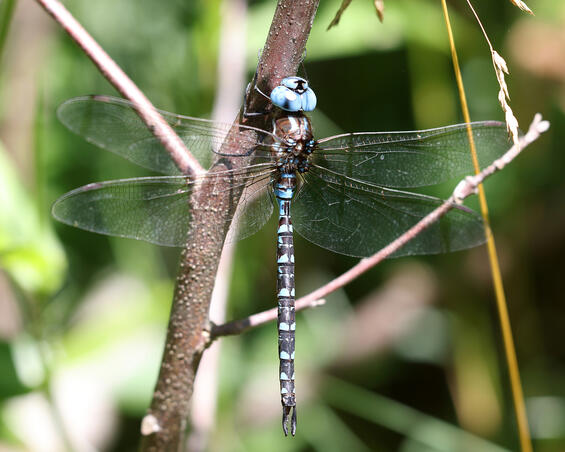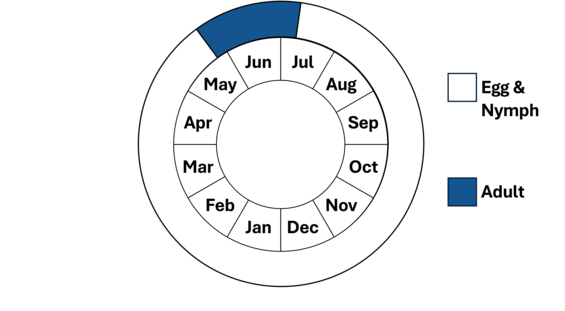- Scientific name: Rhionaeschna mutata
Species of Greatest Conservation Need (MA State Wildlife Action Plan)
Description

Male spatterdock darner
The spatterdock darner is a large, slender insect in the order Odonata, suborder Anisoptera (the dragonflies), and family Aeshnidae (the darners). The species belongs to the genus Rhionaeschna, the neotropical darners, and is the only species that occurs in the northeast region. Overall, the adult body is colored with intense blues and rich browns with black legs and transparent to amber-tinged wings. The adult male thorax (winged and legged section behind the head) is mostly brown, with two pale blue lateral stripes, and the abdomen (the long section behind the thorax) is predominantly brown and marked with sky-blue marks. The face and eyes are also sky-blue in mature individuals. The first two abdominal segments are swollen while the third is constricted, giving a slender-waisted appearance. Females are like males, except blue markings are bluish-green, eyes are a paler blue and possess a tubercle under abdominal segment one.
Adult spatterdock darners range from 67-76 mm (2.6-3 in) in length, with the females averaging somewhat larger. Wingspread ranges from 90-100 mm (3.5-3.9 in). The nymphs and exuviae are relatively long and slender ranging from 38-40 mm (~1.5 in).
Ten species of blue darners (genera Aeshna, Nasiaeschna, and Rhionaeschna) occur regularly in Massachusetts and the spatterdock darner closely resembles many of them in appearance. However, the spatterdock darner is the only blue darner in the Northeast in which the eyes and face are rich blue in color. Nymphs and exuviae can be distinguished from the other darners using characteristics of the labium (lower lip) among other features as per the keys in Walker (1958) and Soltesz (1996), and Tennessen (2019).
Life cycle and behavior

The egg and nymph life stages of spatterdock darner are fully aquatic. The cryptic nymphs are predators foraging on smaller invertebrates and tadpoles and cling to aquatic vegetation and organic debris. Nymphs undergo several molts (instars) for one year until they are ready to emerge as winged adults. Nymphs emerge up onto emergent vegetation or other substrate primarily in late May or early June. When the nymph reaches a secure substrate, the adult begins to push itself out of the exoskeleton. As soon as the abdomen and wings are fully expanded, the adult takes its first flight. This maiden flight usually carries the individuals up into surrounding forest or other areas away from wetlands, where they spend several days maturing and feeding and are somewhat protected from predation and inclement weather. The immature dragonflies spend several days or more feeding and maturing in upland areas away from water, often some distance from the breeding site. Some of the Massachusetts records are from such upland sites, well away from wetlands, and it is impossible to determine the origin of these individuals. Spatterdock darners, like other darners, feed on other aerial insects, which they capture on the wing. When at rest, they hang from vegetation in a vertical position, often high in the trees.
Males patrol the breeding site, typically flying lengthy beats several feet above the water’s surface. When more than one male is present, aggressive interactions are frequent and often end with one male chasing another high over the tree-tops out of sight. Female spatterdock darners appear at the breeding sites when ready to breed. The male uses the claspers at the tip of his abdomen to grab the female behind the eyes. If the female is receptive, she curls her abdomen upward to couple with the male on the underside of his second abdominal segment. Once successfully coupled, the pair flies off high into the nearby woodland to mate. Male dragonflies will mate with as many females as possible; the females may also mate with more than one male. Spatterdock darner females oviposit (lay eggs) in emergent or aquatic vegetation at the water’s surface or the mud in shallow water. The female uses the ovipositor on the underside of her eighth abdominal segment to slice into the stalks or leaves of plants where the egg is deposited. Females have been observed ovipositing in the stems of spatterdock (Nuphar), pondweed (Potamogeton), and the dead stalks of cattails (Typha spp.). The number of eggs laid by an individual female spatterdock darner is not known, but in many dragonfly species often numbers into the hundreds.
Adult spatterdock darners typically first appear in late May and are on the wing into early July.
Distribution and abundance
The spatterdock darner range extends from southwestern Maine south to Virginia and west to Missouri, Michigan, and Ontario. Throughout much of its range, it seems to be scarce and local in occurrence. In New England, spatterdock darners have been recorded from southwestern Maine, southern New Hampshire, Vermont, Massachusetts, Rhode Island, and Connecticut. In Massachusetts, the species occurs most major watersheds including the Housatonic, Farmington, Westfield, Deerfield, Middle Connecticut, Millers, Chicopee, Nashua, Concord, Ipswich, Mystic, Neponset, Taunton, and Cape Cod watersheds. Most records involve just 1-3 individuals, though sizable breeding populations appear to be present at sites in Hampden and Hampshire counties. Massachusetts appears stronghold for this otherwise transient and local northeastern species.

Distribution in Massachusetts.
1999-2024
Based on records in iNaturalist, Odonata Central, and Natural Heritage databases.
Habitat
Typical habitat in Massachusetts seems to be boggy ponds with considerable emergent and floating vegetation. It has also been found in more ephemeral wetlands and may favor fish-free ponds. As its common name implies, spatterdock darners are associated with spatterdock (Nuphar). However, this plant is absent from some Massachusetts sites where the spatterdock darner occurs. The nymphs are aquatic, living among aquatic vegetation and debris of the boggy ponds. The adults inhabit wooded uplands and clearings.
Healthy habitats are vital for supporting native wildlife and plants. Explore habitats and learn about conservation and restoration in Massachusetts.
Small, heavily vegetated pond on Massachusetts’ coastal plain suitable for spatterdock darner.
Threats
Most spatterdock darner sites in Massachusetts are small and presumably fragile wetlands. The greatest threat to this species is likely to be the destruction or degradation of these wetlands from shoreline development, accelerated eutrophication, introduction and spread of aquatic invasive plant and fish species, and impacts of pollution resulting from inadequate sewage treatment, and road run-off. Surface and groundwater withdrawals for human use may also adversely affect spatterdock darners. Climate change may also pose a threat to spatterdock darner especially for populations inhabiting more ephemeral wetlands or ponds that experience large fluctuations in water level.
Conservation
Survey and monitoring
Standardized and targeted surveys for spatterdock darner is needed to update its status in Massachusetts. Surveys should target historical and new wetland sites to determine species occupancy, population status and identify breeding wetlands. Surveys for exuvia and adults are likely to be more effective for detection compared to either one alone. Exuviae surveys should target the species emergence period in late May and early June to maximize detection. Adult surveys should target stream and streambank habitats during their flight period during standardized weather and time windows to maximize species detection. Multiple site visits (e.g., ≥3) may be required to detect this species. Routine monitoring of prioritized sites is needed to estimate occupancy trends overtime.
Management
Protection and restoration of shoreline/littoral zone, riparian, and upland habitat is critical for spatterdock darner persistence in Massachusetts. Actions that can improve or prevent habitat degradation include: reduction of nutrient, agricultural and road runoff; minimization of water level alteration that impacts native aquatic vegetation; minimization of groundwater withdrawals particularly during drought periods; prevention and management of nonnative aquatic vegetation species; development of best practices for herbicide use; limitation and enforcement of off-road vehicles on shoreline habitat; and connection between suitable wetlands.
Research needs
Through standardized surveys, effort is needed to update its distribution, relative abundance, and identify breeding sites in Massachusetts. Research effort is needed to estimate detection and occupancy rates and how other environmental variables (e.g., sample timing, weather) affect these rates. Other research efforts include projections of species distribution under climate change scenarios and climate vulnerability analysis in Massachusetts.
References
Brown, V.A. 2020. Dragonflies and Damselflies of Rhode Island. Rhode Island Division of Fish and Wildlife, Department of Environmental Management, West Kingston RI.
Carpenter, V. 1991. Dragonflies and Damselflies of Cape Cod. Cape Cod Museum of Natural History.
Dunkle, S.W. 2000. Dragonflies Through Binoculars. Oxford University Press.
Lam, E. Dragonflies of North America. Princeton NJ: Princeton University Press, 2024.
Needham, J.G., M.J. Westfall, Jr., and M.L. May. 2000. Dragonflies of North America. Scientific Publishers.
Nikula, B., J.L. Ryan, and M.R. Burne. 2007. A Field Guide to the Dragonflies and Damselflies of Massachusetts, 2nd ed. Massachusetts Natural Heritage and Endangered Species Program.
Paulson, D. Dragonflies and Damselflies of the East. Princeton NJ: Princeton University Press, 2011.
Schilling, E.G., R. Lawrenz, H. Kundel. 2019. A review of the reproductive habitat preferences and conservation challenges of a rare, transient, and ecologically restricted darner dragonfly: Rhionaeschna mutata. International Journal of Odonatology DOI: 10.1080/13887890.2018.1554513
Soltesz, K. 1996. Identification Keys to Northeastern Anisoptera Larvae. Center for Conservation and Biodiversity, University of Connecticut.
Tennessen, K. Dragonfly Nymphs of North America: An identification guide. Springer, 2019.
Walker, E.M. 1958. The Odonata of Canada and Alaska, Vol. II. University of Toronto Press.
Contact
| Date published: | April 9, 2025 |
|---|